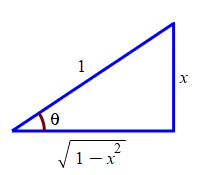7. Trigonometric Substitutions
a2. Substitutions for \(1-x^2\) (or \(x^2-1\)) - Sine Substitutions
Recall the derivative and integral formulas for\(\arcsin x\): \[ \dfrac{d}{dx}\arcsin x=\dfrac{1}{\sqrt{1-x^2}} \qquad \qquad \qquad \int \dfrac{1}{\sqrt{1-x^2}}\,dx=\arcsin x+C \] and the basic Pythagorean Trig Identity written as: \[ 1-\sin^2\theta=\cos^2\theta \] These formulas motivate the following integration technique:
If the integrand involves the quantity \(1-x^2\) (or \(x^2-1\)) and
you know that \(|x| \le 1\), then it may be useful to make the
substitution \(x=\sin\theta\). Then \(dx=\cos\theta\,d\theta\) and
\(1-x^2=1-\sin^2\theta=\cos^2\theta\). So it may be possible to
re-express the integrand in terms of \(\sin\theta\) and \(\cos\theta\) only.
Why do you need to know \(|x| \le 1\)?
Since \(-1 \le \sin\theta \le 1\), if \(|x| \gt 1\) then we cannot set \(x=\sin\theta\).
How do you know if \(|x| \le 1\)?
You look at any quantities inside square roots such as \(\sqrt{1-x^2}\) or at the limits on the integral.
Here are some examples:
Compute \(\displaystyle \int \dfrac{1}{(1-x^2)^{3/2}}\,dx\).
Since \(1-x^2\) is raised to the \(\dfrac{3}{2}\) power, we must have \(1-x^2>0\). So \(x^2<1\) or \(|x|< 1\). So we substitute \(x=\sin\theta\) and \(dx=\cos\theta\,d\theta\) into the integral: \[\begin{aligned} \int \dfrac{1}{(1-x^2)^{3/2}}\,dx &=\int \dfrac{1}{(1-\sin^2\theta)^{3/2}}\cos\theta\,d\theta \\ &=\int \dfrac{\cos\theta}{(\cos^2\theta)^{3/2}}\,d\theta =\int \dfrac{\cos\theta}{\cos^3\theta}\,d\theta \\ &=\int \dfrac{1}{\cos^2\theta}\,d\theta =\int \sec^2\theta\,d\theta\\ &=\tan\theta+C \end{aligned}\] Don't forget to substitute for the differential! Don't forget to substitute back! We already know that \(\sin\theta=x\) from the definition of the substitution. We need a formula for \(\tan\theta\) in terms of \(x\). There are two ways to find this formula:
We can use the Pythagorean identity \(\cos^2\theta=1-\sin^2\theta\). So \(\cos\theta=\sqrt{1-\sin^2\theta}=\sqrt{1-x^2}\) and hence \[ \tan\theta=\dfrac{\sin\theta}{\cos\theta}=\dfrac{x}{\sqrt{1-x^2}} \]
We can draw a right triangle with an angle \(\theta\) whose opposite side is \(x\) and whose hypotenuse is \(1\). These sides are chosen so that \(\sin\theta=\dfrac{x}{1}=x\). Then the adjacent side is \(\sqrt{1-x^2}\) and so: \[ \tan\theta=\dfrac{x}{\sqrt{1-x^2}} \]

In either case the original integral becomes: \[ \int \dfrac{1}{(1-x^2)^{3/2}}\,dx =\dfrac{x}{\sqrt{1-x^2}}+C \]
We check by differentiating. If \(f(x)=\dfrac{x}{\sqrt{1-x^2}}\), then \[\begin{aligned} f'(x) &=\dfrac{\sqrt{1-x^2}(1) -x\left(\dfrac{-x}{\sqrt{1-x^2}}\right)}{1-x^2} \\[5pt] &=\dfrac{(1-x^2)+x^2}{(1-x^2)^{3/2}} =\dfrac{1}{(1-x^2)^{3/2}} \end{aligned}\] which is the integrand we started with.
It is absolutely crucial that you write the \(dx\) and \(d\theta\) and remember to substitute for the differential. Otherwise, you will get the wrong answer. If you do not substitute for the differential here is what you might get:
\[\begin{aligned} \int &\dfrac{1}{(1-x^2)^{3/2}}\,dx =\int \dfrac{1}{(1-\sin^2\theta)^{3/2}}\,d\theta \qquad\qquad\text{missing}\,\cos\theta \\ &=\int \dfrac{1}{(\cos^2\theta)^{3/2}}\,d\theta =\int \dfrac{1}{\cos^3\theta}\,d\theta =\int \sec^3\theta\,d\theta \\ &=\dfrac{1}{2}\sec x\tan x+\dfrac{1}{2}\ln|\sec x+\tan x|+C \end{aligned}\] which was much harder to integrate. We still need to substitute back, but we won't because the solution is wrong anyway!
Compute \(\displaystyle \int_0^{1/2} \dfrac{1}{x^2-1}\,dx\).
From the limits, we see that \(0 \le x \le \dfrac{1}{2}\) and hence \(|x| \le 1\). So we substitute \(x=\sin\theta\). Then \(dx=\cos\theta\,d\theta\). Rather than substituting back, we change limits. So: \[\begin{aligned} \int_0^{1/2} \dfrac{1}{x^2-1}\,dx &=\int_0^{\pi/6} \dfrac{1}{\sin^2\theta-1}\cos\theta\,d\theta =\int_0^{\pi/6} \dfrac{1}{-\cos^2\theta}\cos\theta\,d\theta \\ &=-\int_0^{\pi/6} \dfrac{1}{\cos\theta}\,d\theta =-\int_0^{\pi/6} \sec\theta\,d\theta \\ &=-\left[\dfrac{}{}\ln|\sec\theta+\tan\theta|\right]_0^{\pi/6} \\ &=-\ln\left|\sec\dfrac{\pi}{6}+\tan\dfrac{\pi}{6}\right|+\ln|\sec0+\tan0| \\ &=-\ln\left|\dfrac{2}{\sqrt{3}}+\dfrac{1}{\sqrt{3}}\right|+\ln|1| \\ &=-\ln\sqrt{3} \end{aligned}\]
Now it's your turn:
Compute \(\displaystyle \int_0^1 \sqrt{1-x^2}\,dx\).
Let \(x=\sin\theta\).
\(\displaystyle \int_0^1 \sqrt{1-x^2}\,dx =\dfrac{\pi}{4}\)
We substitute \(x=\sin\theta\) and \(dx=\cos\theta\,d\theta\). \[\begin{aligned} \int_0^1 \sqrt{1-x^2}\,dx &=\int_0^{\pi/2} \sqrt{1-\sin^2\theta}\,\cos\theta\,d\theta =\int_0^{\pi/2} \cos^2\theta\,d\theta \\ &=\int_0^{\pi/2} \dfrac{1+\cos2\theta}{2}\,d\theta =\dfrac{1}{2}\left[\theta+\dfrac{\sin 2\theta}{2}\right]_0^{\pi/2} \\ &=\dfrac{\pi}{4} \end{aligned}\]
It is easier to do this integral if we recognize that it is the area of the region below \(y=\sqrt{1-x^2}\) for \(0 \le x \le 1\), which is a quarter circle of radius \(1\). So: \[ \int_0^1 \sqrt{1-x^2}\,dx=\dfrac{1}{4}\pi(1)^2=\dfrac{\pi}{4} \]
Compute \(\displaystyle \int \dfrac{x}{(1-x^2)^2}\,dx\) assuming \(|x|<1\).
Let \(x=\sin\theta\). Or use the ordinary substitution \(u=1-x^2\).
\(\displaystyle \int \dfrac{x}{(1-x^2)^2}\,dx =\dfrac{1}{2(1-x^2)}+C\)
We substitute \(x=\sin\theta\) and \(dx=\cos\theta\,d\theta\): \[\begin{aligned} \int \dfrac{x}{(1-x^2)^2}\,dx &=\int \dfrac{\sin\theta}{(1-\sin^2\theta)^2}\cos\theta\,d\theta \\ &=\int \dfrac{\sin\theta}{\cos^3\theta}\,d\theta \end{aligned}\] Now let \(u=\cos\theta\). Then \(du=-\sin\theta\,d\theta\). So: \[ \int \dfrac{x}{(1-x^2)^2}\,dx =-\int \dfrac{1}{u^3}\,du =\dfrac{1}{2u^2}+C \] Finally we substitute back: \[\begin{aligned} \int \dfrac{x}{(1-x^2)^2}\,dx &=\dfrac{1}{2\cos^2\theta}+C =\dfrac{1}{2(1-\sin^2\theta)}+C \\ &=\dfrac{1}{2(1-x^2)}+C \end{aligned}\] This solution was unnecessarily complicated. Always look for an ordinary substitution first:
We substitute \(u=1-x^2\). Then \(du=-2x\,dx\) and \(-\,\dfrac{1}{2}\,du=x\,dx\). So, \[\begin{aligned} \int \dfrac{x}{(1-x^2)^2}\,dx &=-\,\dfrac{1}{2}\int \dfrac{1}{u^2}\,du =\dfrac{1}{2u}+C \\ &=\dfrac{1}{2(1-x^2)}+C \end{aligned}\]
We check by differentiating. If \(f(x)=\dfrac{1}{2(1-x^2)}\) then \[\begin{aligned} f'(x) &=-\,\dfrac{1}{2}\dfrac{-2x}{(1-x^2)^2} \\ &=\dfrac{x}{(1-x^2)^2} \end{aligned}\] which is the integrand we started with.
Heading
Placeholder text: Lorem ipsum Lorem ipsum Lorem ipsum Lorem ipsum Lorem ipsum Lorem ipsum Lorem ipsum Lorem ipsum Lorem ipsum Lorem ipsum Lorem ipsum Lorem ipsum Lorem ipsum Lorem ipsum Lorem ipsum Lorem ipsum Lorem ipsum Lorem ipsum Lorem ipsum Lorem ipsum Lorem ipsum Lorem ipsum Lorem ipsum Lorem ipsum Lorem ipsum